Как повысить коррозионную стойкость и химическую устойчивость ппр-муфт?
Feb.22.2024
Повышение коррозионной стойкости и химической устойчивости соединителей PPR может быть достигнуто различными методами и технологиями. Вот некоторые стратегии: Модификация материала: Улучшение химической и коррозионной стойкости соединителей PPR путем добавления модификаторов или добавок в состав материала. Эти добавки могут включать антиоксиданты, стабилизаторы или ингибиторы, которые защищают полимерную матрицу от разрушения при воздействии коррозионных веществ.
Обработка поверхности: Нанесение защитного покрытия или обработка поверхности соединителя PPR для создания барьера против коррозионных агентов. Это можно осуществить с помощью методов, таких как электроосаждение, химическое покрытие или плазменное напыление, которые образуют тонкий слой коррозионностойкого материала на поверхности соединителя.
Композитные материалы: Используйте композитные материалы или гибридные структуры для комбинирования присущих свойств ППР с другими материалами, устойчивыми к коррозии. Например, включение стекловолокна или углеродного волокна в матрицу ППР может повысить ее механическую прочность и сопротивляемость химическому воздействию.
Специальные формулы: Разработайте специальные формулы ППР, адаптированные для конкретных приложений или условий, где требуется повышенная коррозионная стойкость. Эти формулы могут включать дополнительные добавки или модификаторы, предназначенные для повышения сопротивляемости определенным химическим веществам или условиям окружающей среды.
Контроль качества: Внедрите строгие меры контроля качества во время производственного процесса, чтобы гарантировать, что муфты ППР соответствуют установленным стандартам химической и коррозионной стойкости. Это включает использование высококачественного сырья, поддержание постоянных параметров производства и проведение тщательных испытаний и процедур контроля.
Правильная установка: Обеспечьте правильную установку соединителей PPR в системах водоснабжения, чтобы минимизировать воздействие коррозионных веществ и предотвратить повреждение или разрушение. Это включает соблюдение рекомендаций производителя по подготовке соединений, техникам сварки и проектированию системы для поддержания ее целостности и эффективности в течение длительного времени.
Регулярное обслуживание: Внедряйте регулярные процедуры обслуживания и осмотра для контроля состояния соединителей PPR и своевременного устранения любых признаков коррозии или износа. Это может включать очистку, промывку или обработку системы водоснабжения для удаления накопленных загрязнений или примесей, которые могут снижать эффективность.
Внедрение этих стратегий позволяет повысить коррозионную стойкость и химическую устойчивость соединителей PPR, обеспечивая долговечность и надежность в различных системах водоснабжения.


 EN
EN
 AR
AR
 BG
BG
 HR
HR
 CS
CS
 DA
DA
 NL
NL
 FR
FR
 DE
DE
 EL
EL
 IT
IT
 JA
JA
 KO
KO
 PL
PL
 PT
PT
 RO
RO
 RU
RU
 ES
ES
 SV
SV
 TL
TL
 IW
IW
 SR
SR
 SK
SK
 UK
UK
 VI
VI
 SQ
SQ
 ET
ET
 HU
HU
 MT
MT
 FA
FA
 AF
AF
 MS
MS
 GA
GA
 CY
CY
 IS
IS
 AZ
AZ
 LA
LA
 MN
MN
 UZ
UZ
 KY
KY

